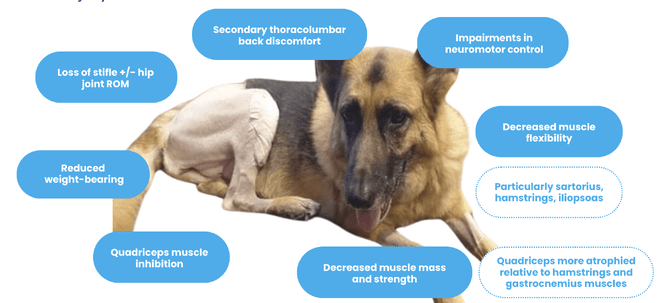What is canine cruciate injury?
Cranial cruciate ligament (CCL) injury is the leading cause of hindlimb lameness in the dog with a prevalence of approximately 11% in the canine population (1). Injury to the cruciate ligament can result from a high-load traumatic event, however for dogs, in most cases:
It is the result of normal forces placed on an abnormal, degenerative ligament
It is progressive, beginning with gradual degeneration and progressing from partial ligament injury to complete rupture
The same disease process often occurs in the CCL of both hindlimbs (2)
Why is physiotherapy following cruciate injury or surgery SO important for dogs?
After cruciate injury or surgery: There is muscle atrophy, loss of stifle joint (knee) movement, reduced weightbearing on the affected leg, and impaired muscle control. Research has shown these deficits remain unless directly addressed with physiotherapy (1,2)
Muscle Inhibition: The phenomenon of muscle inhibition is the body’s protective response to injury or surgery. This prevents further damage at the time of injury/surgery, but often leads to muscular atrophy, joint stiffness, and altered movement patterns if left unaddressed. Physiotherapy is vital for directing treatment to muscle rehabilitation.
Preventing post-operative complications: Research has found that people with anterior cruciate ligament (ACL) repair that are overweight, have multiple knee injuries at the time of surgery, or compete in elite level sports are at a significantly increased risk of developing knee osteoarthritis, and for athletes, there is a more than 4-fold increase in potential for reinjury (3). We see a similar representation in dogs with cruciate injury.
How does physiotherapy help dogs recover from cruciate injury or surgery?
Physiotherapy in people following anterior cruciate ligament repair in people has been shown to:
reduce pain
increase joint range of movement
increase muscle mass and strength (especially of the quadriceps muscle)
facilitate return to daily life activities and sport (3,4,5,6)
Similar findings were found in dogs following TPLO surgery for cruciate disease (Click here to read more).
We find there are three key areas where physiotherapy results in accelerated recovery for dogs following cruciate injury/surgery:
Pain management: Physiotherapists use a broad range of modalities to mitigate pain, including hot/cold therapies, electrical stimulation, soft tissue massage and more. It is very important to ensure good pain management so dogs can fully participate in physiotherapy.
Muscle re-education: Physiotherapists have specialist skills in exercise prescription. We prescribe exercises specific to the patient’s condition, that focus on re-establishing the proper communication channels between muscles and the nervous system, and ensure correct muscle activation patterns are used.
Progressive loading: Physiotherapists develop rehabilitation programmes that gradually increase the intensity, volume and complexity of exercises to align with the body’s natural healing rate. The RIGHT dose, at the RIGHT time, to ensure continual upward progress.
Initiating physiotherapy as soon as possible following cruciate injury or surgery will ensure the best outcomes for dogs.
References
1. Powers, M.Y., Martinez, S.A., Lincoln, J.D., et al. (2005) ‘Prevalence of cranial cruciate ligament rupture in a population of dogs with lameness previously attributed to hip dysplasia: 369 cases (1994-2003)’, Journal of the American Veterinary Medical Association, 227(7), pp. 1109– 1111. DOI: https://doi.org/10.2460/javma.2005.227.1109
2. Hayashi, K., Frank, J.D., Dubinsky, C., Zhengling, H., Markel, M.D., Manley, P.A., and Muir, P. (2003) ‘Histologic changes in ruptured canine cranial cruciate ligament, Veterinary Surgery, 32, pp. 269–277.
3. H., Granan, L.P., Risberg, M.A., Engebretsen, L., Snyder-Mackler, L., and Eitzen, I. (2015) ‘How does a combined preoperative and postoperative rehabilitation programme influence the outcome of ACL reconstruction 2 years after surgery? A comparison between patients in the Delaware-Oslo ACL Cohort and the Norwegian National Knee Ligament Registry’, British Journal of Sports Medicine, 49(6), pp. 385 - 389.
4. Filbay, S.R., and Hege Grindem, H. (2019) ‘Evidence-based recommendations for the management of anterior cruciate ligament (ACL) rupture’, Best Practice and Research Clinical Rheumatology, 33, pp. 33 – 47. DOI: https://doi.org/10.1016/j.berh.2019.01.018 British Orthopaedic Association. (2020, September). BASK-BOSTAA - Best Practice Book on Management of Anterior Cruciate Ligament Injuries. https://www.boa.ac.uk/static/88a4c3e3-df3e-4e51- a92e7d2f86d7d82a/Best-Practice-Book-for-management-of-Anterior-Cruciate-Ligament- injuries.pdf
5. Australian Orthopaedic Association and Australian Knee Society. (2021, October). Consensus Position Statement on Non-Operative and Operative Management in Anterior Cruciate Ligament Injury. https://www.kneesociety.org.au/resources/Final-Consensus-Position- Statement-on-OP-vs-Non-op-ACL-Mx-2021.pdf
6. British Orthopaedic Association. (2020, September). BASK-BOSTAA - Best Practice Book on Management of Anterior Cruciate Ligament Injuries. https://www.boa.ac.uk/static/88a4c3e3- df3e-4e51-a92e7d2f86d7d82a/Best-Practice-Book-for-management-of-Anterior-Cruciate- Ligament-injuries.pdf




